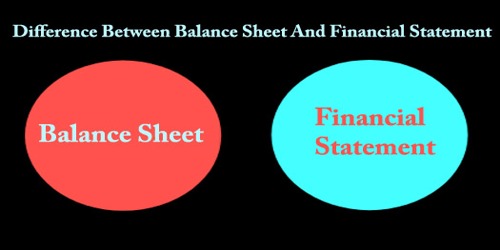Definition of Balance Sheet –
Balance Sheet is a summary of the financial balances of an individual or an organization. A balance sheet is often described as a snapshot of a company’s financial condition as on a particular date which consists of all the Assets and Liabilities of the Organization.
There are two heads in a Balance Sheet, Assets, and equity & liability. In the asset head, all the current assets and the non-current assets of the entity are covered while the equity and liabilities head will comprise of shareholder’s equity and all the current and non-current liabilities.
The difference between the assets and liabilities is the net assets or net worth of the company which can also be termed as owner’s equity. The Balance Sheet is prepared at a particular date which is usually the end of the financial year and is publicly reported as a part of the Financial Statement.
Definition of Financial Statement –
Financial Statements are accounting reports which elucidate the financial position of the entity on that particular date. Financial statements comprise of Balance Sheet, Profit or Loss Statement, Cash Flow Statement, Audit Report, and Directors Report on that particular date.
It provides a clear view of the financial health and information of the company. It is publicly reported at the end of the financial year, which allows its stakeholders to know the performance of the entity. It ensures the investors and creditors to understand how accurately their funds have been utilized.
Thus the financial statements are a comprehensive bunch of documents that cover the entire financial position of the entity whereas the balance sheet only provides the sources of funds and this application.
Key Differences between the Balance Sheet and Financial Statement –
The points are given below explain the differences between balance sheet and statement of financial position, i.e. financial statement:
- A Balance Sheet represents the financial condition of any entity at a particular date. Financial Statement describes the financial status of the concern quantitatively.
- A Balance Sheet reveals the assets owned and debts owed by the entity, whereas the Financial Statement reflects the health of the entity.
- A Balance Sheet is a part of the Financial Statement, but Financial Statement is not a part of the Balance Sheet.
The financial statement is a generic term whereas the Balance Sheet is a statement showing assets and liabilities on a particular date. So balance sheet can also be categorized as a financial statement. It is obligatory for every company to furnish its financial statements publicly at the end of the period.
A Balance Sheet is a vital part of a Financial Statement that is often used by many stakeholders. Although, there are other parts of the financial statement through which the scope of the financial statement is much wider than that of a Balance Sheet. Therefore, Balance Sheet alone is not regarded as a Financial Statement.
Information Sources:
















